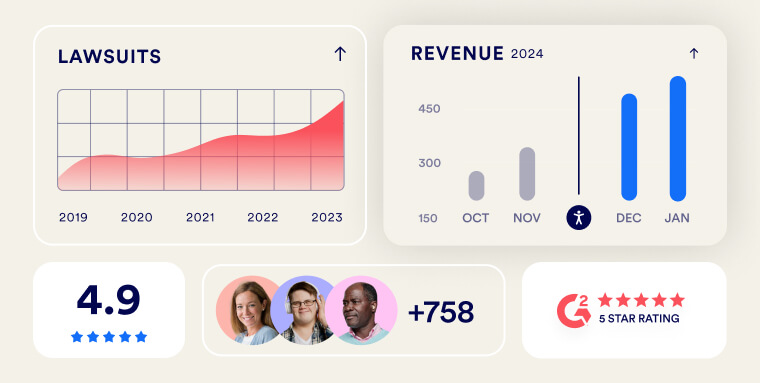The information presented within this guide is aimed at website owners seeking to learn the ropes of web accessibility and to create a more inclusive online environment for people with disabilities. Technical elements are described in layman’s terms, and, as a rule, all topics pertaining to the legalities of web accessibility are presented in as simplified a manner as possible. This blog has no legal bearing, and cannot be relied on in the case of litigation.
Did you know that eight out of the top ten most frequented online Canadian retailers have accessibility issues within their websites?
And while they are highly prominent examples, these sites are hardly the only ones which present obstacles for potential customers with disabilities.
Luckily, with the right tools and methods, you can fight this trend and become fully inclusive and accessible. This will result in you appealing to the widest possible audience, and see you fulfill your legal obligations under the Accessibility for Ontarians with Disabilities Act (AODA)
In this article, we’re going to showcase why Canadian online retailers should invest in ensuring their websites and web-based environments are accessible to everyone, regardless of ability. We’ll show you how implementing accessibility measures will not only see you complying with the AODA, but also present you with significant business results.
A quick introduction to web accessibility
It is crucial that individuals with disabilities are given equal access to digital spaces. Currently, a majority of websites and online applications pose considerable barriers for members of various disability communities, often obstructing or completely denying their ability to purchase goods and services online.
Business and website owners aiming to create a more inclusive and welcoming online presence, as well as comply with relevant web accessibility laws (which will be explained shortly), must ensure their websites align with the Web Content Accessibility Guidelines (WCAG).
Developed by the World Wide Web Consortium (W3C), WCAG is the most prominent and accepted set of web accessibility standards, and it underpins numerous international web accessibility regulations.
At their core, WCAG is based upon four guiding principles:
- Perceivable: Information and user interface components must be presented in a way that users can perceive
- Operable: User interface components and navigation must be operable via keyboard and other accessible means
- Understandable: Information and operation of the user interface must be understandable
- Robust: Content must be robust enough to work with current and future technologies
To be considered accessible, websites need to conform to WCAG.
WCAG has a deciding impact on web accessibility. Therefore, gaining a better grasp of its sections, versions, and conformance levels is key for retail businesses aiming to properly tackle this issue. We recommend you check out these articles for further information on this topic:
Why Canadian online retailers need to care about web accessibility

Web accessibility is a legal requirement under the AODA
Under the Accessibility for Ontarians with Disabilities Act (AODA), retail businesses are legally required to ensure their digital environments are accessible. Enacted to protect the rights of individuals with disabilities within the province of Ontario, the AODA mandates that websites conform to the Web Content Accessibility Guidelines (WCAG).
The AODA applies to many public sector organizations, non-profit organizations, and privately-owned businesses. The latter category includes retail companies, which are required to provide equal access and protection within their digital spaces.
Complying with the AODA requires your website adhere to WCAG 2.0, an earlier version of these guidelines, at Level AA.
We recommend you read more about this process by checking out our guide on AODA compliance, and our comprehensive AODA compliance checklist.
The consequences of not complying with the AODA
If your online retail business does not comply with the AODA by falling short of full WCAG conformance, you risk facing legal actions and incurring various penalties.
The sum you potentially may be forced to pay is determined based on the nature of the violation and the offender's previous contraventions, categorized into minor, moderate, and major impacts and histories. For example, minor impacts involve administrative lapses, while major impacts pose significant risks to health or safety.
The fines for AODA non-compliance vary widely: individuals with a minor contravention history could be fined between $200 and $500, while corporations with a major contravention history and severe impact could face fines between $5,000 and $15,000.
In the most severe cases, daily penalties can escalate to $100,000 for corporations and $50,000 for individuals or unincorporated organizations.
Just as importantly, failing to comply with the AODA can potentially harm your brand reputation.
Failing to provide people with disabilities with the accommodations they rightfully deserve can be perceived as an act of discrimination.
As we will see in a moment, Canadian consumers have made their voice clear on the matter of supporting businesses that showcase a lack of social responsibility and awareness. Failing to be inclusive toward members of various disability communities can lead existing and potential customers to look elsewhere.
Bottom line: Many Ontario businesses need to comply with the Accessibility for Ontarians with Disabilities Act (AODA), and present an accessible website. Failing to comply with the law, in the form of WCAG adherence, can result in significant financial penalties and a tarnished reputation.
Web accessibility is smart business
In today’s digital-first marketplace, it’s crucial to broaden access to your online store, and welcome the maximum number of potential consumers. Canadians with disabilities represent a significant market, controlling considerable purchasing power that was estimated at CAD 55 billion in 2017. It stands to reason that this sum has increased since.
Ensuring that your website, apps, and other customer-facing digital platforms are accessible opens your retail business to a broader audience, including the more than 27% of Canadians over the age of 15 who live with some form of disability. These potential customers are ready to invest in your products and services if they can navigate your digital spaces effectively.
It's crucial to remember that the average online shopping cart abandonment rate stands at 70.19%. This figure does not reflect the specific challenges encountered by individuals with disabilities during their online shopping experiences.
These potential customers are often unable to even approach the final stages of the purchasing process, abandoning their shopping efforts well before reaching the checkout stage.
Bottom line: Investing in accessibility will open your online business up to a large audience that commands tens of millions of Canadian dollars in expendable income.
Canadian consumers expect their brands to be inclusive and accessible
Research conducted by Canada Post in 2022 yielded some significant insights on how Canadians’ choose to support specific brands and companies. Surveying 5000 online shoppers, the study found that Canadian consumers gravitate toward businesses that align with their own beliefs and values.
Some of the key findings include:
- 25% of survey respondents claimed they prefer to support brands that have strong values and that are genuinely committed to doing the right thing
- 16% of respondents claimed they stopped supporting brands they had in the past, with many citing these brands’ lack of alignment with their own beliefs as the primary reason.
Bottom line: Investing in accessibility falls squarely into the category of ‘doing the right thing’, and is a testament that your business is truly inclusive. Socially conscious consumers are far more likely to gravitate toward your brand, and to potentially support it.
Take the next step

Web accessibility requires tackling specific areas of your website and web-based applications, using a variety of tools and approaches.
As an online retailer, your website features dynamic content which requires significant tweaking. Additionally, as mobile usage plays such a significant role in Canadian online shopping, and is projected to become even more dominant in the next few years, the solution and approach you choose will need to be one that tackles accessibility across all platforms and stages.
You are therefore best-suited to rely on dynamic accessibility solutions built with your use-case in mind.
Web accessibility platforms like accessiBe offer a number of tools and services which each tackle individual stages of the accessibility journey, as well as target specific digital assets and environments, such as online documents and mobile adaptation.
If you’re interested in learning more about the ways in which accessiBe can help you on your journey toward accessibility, press here.
________________
Methodology: The websites were audited using accessScan, accessiBe's free web accessibility tester, which examines web pages for WCAG adherence.


